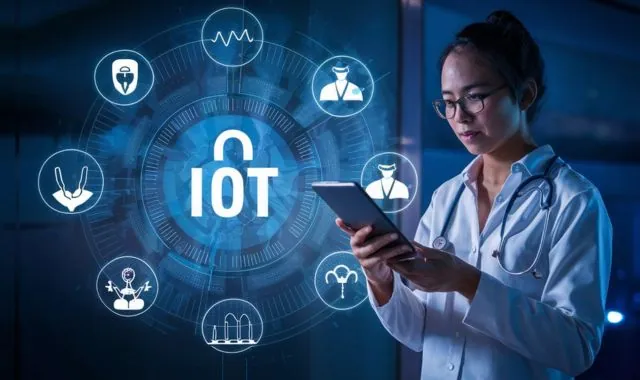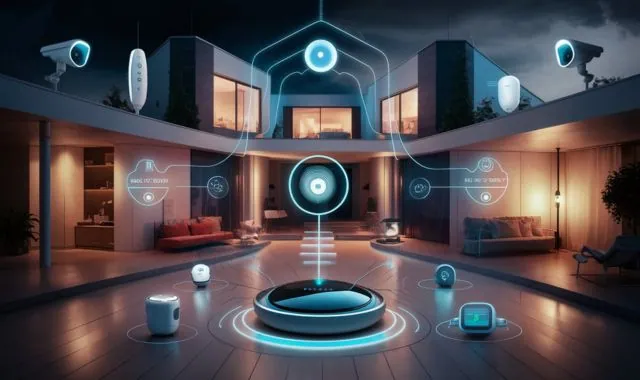Physical Address
304 North Cardinal St.
Dorchester Center, MA 02124
Physical Address
304 North Cardinal St.
Dorchester Center, MA 02124

The Internet of Things IoT is weaving a web of connectivity in our daily lives. It connects everyday objects with sensors, software, and networks, allowing them to collect and exchange data. This data can be used to automate tasks in our homes, improve efficiency in industries, and even transform our cities. While security and data management are concerns, the potential of IoT to improve our lives is vast.

Imagine a world where your toaster can tell you when your bread is perfectly browned, your refrigerator can automatically reorder milk when you’re running low, and even your city can optimize traffic flow based on real-time data. This interconnected reality is no longer science fiction; it’s the dawn of the Internet of Things IoT.
The IoT refers to a vast network of physical devices – from everyday appliances to complex industrial machinery – embedded with sensors, software, and other technologies that enable them to connect and exchange data with other devices and systems over the internet.
The possibilities of IoT are truly boundless. In our homes, we can have smart speakers that control our lighting, thermostats that adjust to our preferences, and security systems that monitor our property. But the reach of IoT extends far beyond our doorsteps. In cities, traffic lights can communicate with each other to optimize traffic flow, while wearables can track our health and fitness data. Even agricultural equipment can be connected to collect real-time data on soil conditions and crop health.
This interconnected world relies on three key elements:
These tiny devices act as the eyes and ears of IoT, collecting data about the surrounding environment, such as temperature, motion, or pressure.
The brains behind the operation, software processes the data collected by sensors, interprets it, and instructs the device on how to respond.
This intricate web of connections allows devices to communicate with each other and with the cloud, enabling data exchange and remote control.
The inner workings of IoT can be broken down into three crucial steps:
Sensors are the foundation of any IoT system. They come in various forms, from simple temperature sensors in thermostats to complex image sensors in security cameras. These sensors gather a wide range of data, from temperature and humidity to motion and sound.
Imagine a smart thermostat that uses temperature sensors to adjust your home’s climate automatically. Or, consider a traffic management system that utilizes road sensors to detect congestion and optimize traffic flow in real-time. These are just a few examples of how sensors are transforming our world.
The collected data is then processed by microcontrollers, tiny computers embedded within IoT devices. These microcontrollers analyze the sensor data, make decisions based on pre-programmed instructions, and control the device’s actions.
Once processed, the data needs to be transmitted. This is where communication protocols come in, establishing a common language for devices to communicate. The data is then sent over various networks, such as Wi-Fi, Bluetooth, or cellular networks, to other devices, cloud platforms, or control centers.
The true power of IoT lies in its ability to connect devices and generate valuable data. This data can be used to improve our lives in numerous ways.
Imagine a home that anticipates your needs. With smart home devices, you can control your lighting, adjust the thermostat, and even lock your doors remotely using your smartphone. IoT can automate routine tasks, freeing up your time and energy for the things that matter most.
Smart thermostats can learn your preferences and automatically adjust the temperature for optimal comfort and energy efficiency. Similarly, smart lighting systems can create personalized lighting scenes based on your mood or activity.
IoT goes beyond convenience. Smart security systems can monitor your home for intruders and send real-time alerts. Wearables with built-in sensors can even detect falls and alert emergency services, providing peace of mind and improving safety.

The impact of IoT extends far beyond our homes. Industries are leveraging IoT to streamline operations and improve efficiency.
Imagine factory equipment that can predict its own maintenance needs. With IoT sensors, machines can monitor their performance and send alerts for potential issues before they snowball into major breakdowns. This approach, known as predictive maintenance, saves businesses time and money
The potential of IoT extends far beyond our current experiences. Here’s a peek into what the future holds:
Imagine cities that manage traffic flow in real-time, optimize waste collection, and even monitor air quality – all thanks to a network of connected devices. Smart cities promise a more sustainable, efficient, and livable urban environment.
IoT can revolutionize healthcare. Wearable devices can track vital signs and health metrics, allowing for personalized medicine and remote patient monitoring. This can lead to earlier detection of health issues and improved overall well-being.

Environmental monitoring systems with IoT sensors can track air and water quality, providing valuable data for conservation efforts. Smart irrigation systems can optimize water usage in agriculture, promoting sustainability and resource management.
The future of IoT is brimming with possibilities. As technology continues to evolve and connectivity becomes more seamless, we can expect a world where devices work together to create a more efficient, secure, and sustainable future.
The Internet of Things IoT is rapidly transforming our world, weaving a web of connectivity that touches every aspect of our lives. From the convenience of smart homes to the efficiency of connected industries, the benefits of IoT are undeniable. While challenges like security and data management exist, the potential for a more automated, efficient, and sustainable future is undeniable. As we move forward, embracing responsible development and innovation will be key to unlocking the full potential of this revolutionary technology.
IoT devices come in all shapes and sizes! In your home, you might have smart speakers, thermostats, or security systems. In cities, traffic lights, wearables, and even agricultural equipment can be part of the IoT network.
IoT devices use sensors to collect data about their surroundings. This data is then processed by microcontrollers and transmitted over networks to other devices or the cloud.
IoT offers a variety of benefits, including:
Automate tasks in your home with smart devices.
Monitor your home or wearables for security or health concerns.
Industries can optimize operations with predictive maintenance and data-driven insights.
Improve environmental monitoring and resource management with connected sensors.
Security and data privacy are major considerations with interconnected devices. Additionally, managing and analyzing the vast amount of data generated by IoT devices can be complex.
The future of IoT is bright! We can expect smarter cities with real-time traffic management and environmental monitoring. Healthcare is poised for a revolution with connected wearables and remote patient monitoring. Overall, IoT has the potential to create a more efficient, secure, and sustainable world.